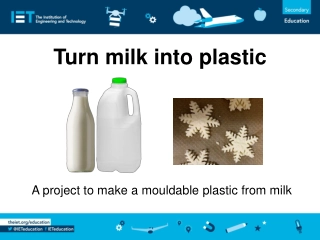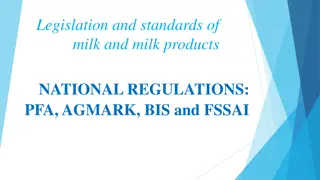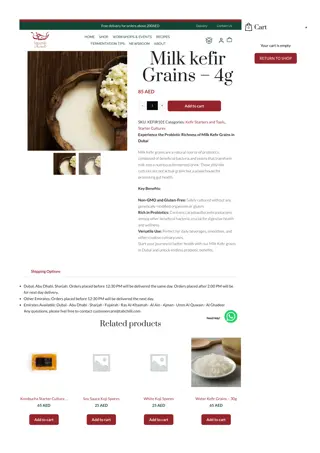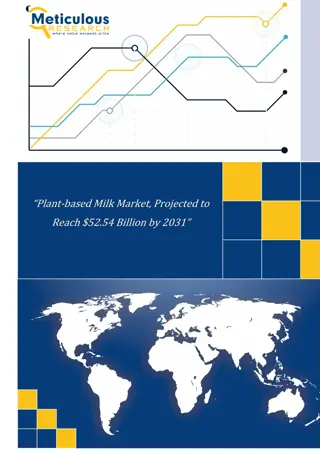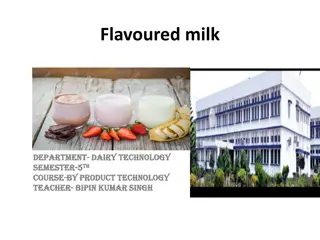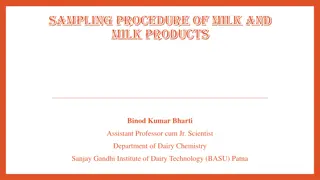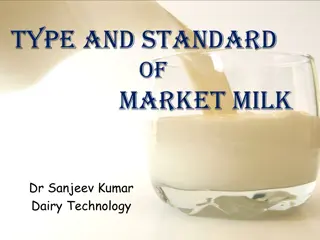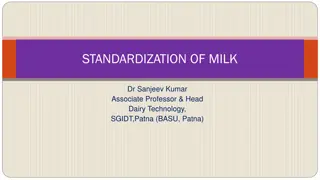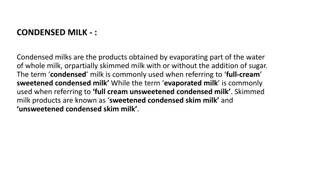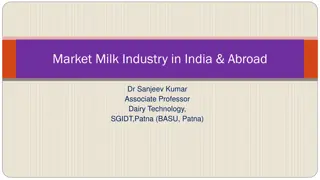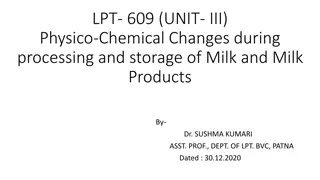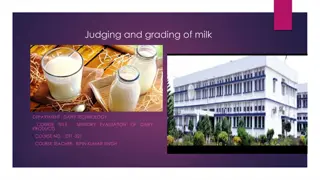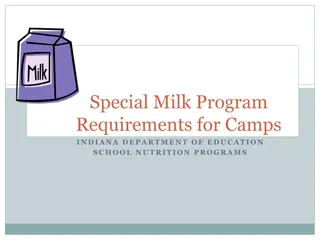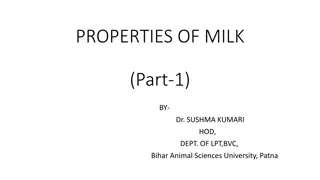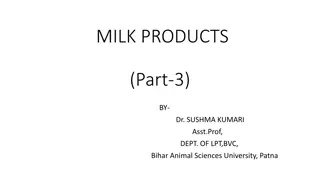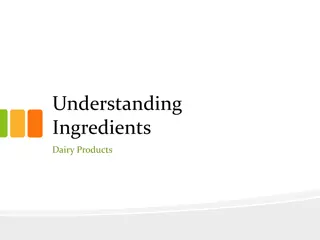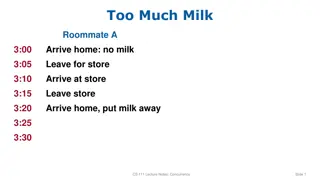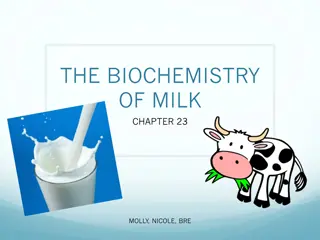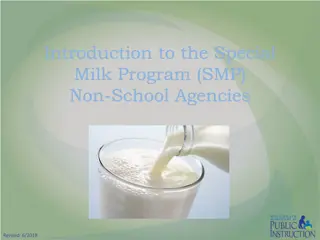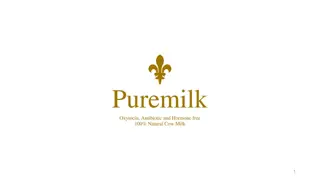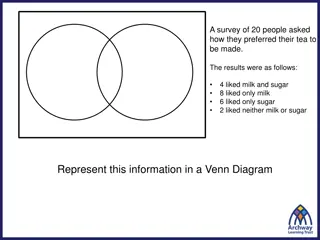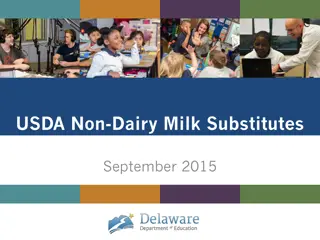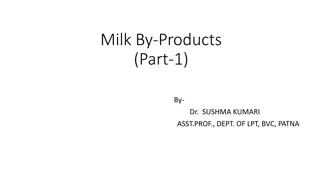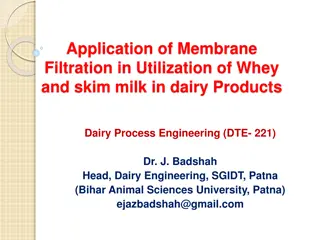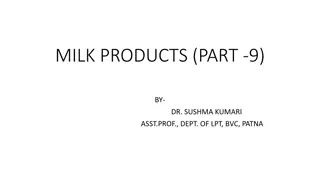Turn milk into plastic
Make mouldable plastic from milk with a simple DIY project. Follow step-by-step instructions to create your own plastic at home using milk and vinegar. Discover the fascinating history of milk-based plastic and its applications. Stay safe by following the safety guidelines provided in the activity.
0 views • 8 slides
Plant-based Milk Market: Application and Benefits
Meticulous Research\u00ae\u2014a leading global market research company, published a research report titled \u2018Plant-based Milk Market by Type (Almond Milk, Soy Milk, Coconut Milk, Oat Milk, Rice Milk), Formulation (Unflavored, Flavored), Distribution Channel (B2B, B2C [Modern Groceries, Convenie
1 views • 3 slides
Understanding Condensed Milk: A Comprehensive Overview
Condensed milk is cow's milk from which water has been removed, typically found with added sugar. There are two types: unsweetened and sweetened condensed milk. The product has a long shelf-life due to its high sugar content. It is used in various dessert dishes worldwide and can be a substitute for
3 views • 11 slides
Milk and Milk Products Standards in India
In India, regulations for milk and milk products are governed by various bodies such as PFA, AGMARK, BIS, and FSSAI. The country has legal standards set by the government under the PFA Rules, 1955, ensuring minimum requirements for quality and safety. Additionally, there are quality standards like B
4 views • 36 slides
Insights into Milk Composition and Processing
Worldwide, milk is collected from various animals such as cows, goats, sheep, yaks, and water buffalo. The composition of milk includes water, lactose, butterfat, protein, and minerals, each playing a vital role in its nutritional value. The butterfat content determines the richness of dairy product
7 views • 41 slides
Milk Kefir Grains Dubai - Rich In Probiotics
Milk kefir is a probiotic powerhouse, but can be hard to find in Dubai. the scoop on where to buy milk kefir grains locally and how to brew the tasty fermented milk at home.\n
0 views • 2 slides
Plant-based Milk Market, Projected to Reach $52.54 Billion by 2031
Plant-based Milk Market Size, Share, Forecast, & Trends Analysis by Type (Almond Milk, Soy Milk, Coconut Milk, Oat Milk, Rice Milk), Formulation (Flavored), Distribution Channel (B2B, B2C [Modern Groceries, Convenience Store]) - Global Forecast to 2031\n
0 views • 3 slides
Flavoured Milk: Delicious Varieties and Health Benefits
Flavoured milk is a popular dairy drink enjoyed by children and adults alike. It is made by adding flavorings and sugar to milk, resulting in delicious options like Chocolate, Marshmallow, Cherry, and more. Despite containing added sugar, flavoured milk retains the essential nutrients of plain milk
0 views • 11 slides
Proper Sampling Procedure of Milk and Milk Products
Proper sampling of milk and milk products is crucial for accurate chemical analysis. This article covers the sampling procedures for various dairy products like milk, cream, paneer, ghee, and more. It emphasizes the importance of experienced personnel, sterile equipment for bacteriological testing,
1 views • 28 slides
Overview of Market Milk: Types, Standards, and Microbiological Quality
Market milk encompasses various types such as standardized, full cream, and skimmed milk, each with specific standards and microbiological requirements. Factors affecting microbiological quality include raw milk quality and processing steps. Understanding these aspects is crucial for maintaining the
0 views • 22 slides
Sensory Evaluation of Milk Powder in Dairy Technology: Flavors and Characteristics
Sensory evaluation is crucial for determining the quality and shelf life of milk powder products. This study focuses on sensory analysis methods to identify flavors and physical characteristics of whole milk powder, skim milk powder, and malted milk. It discusses common flavor defects, texture varia
2 views • 12 slides
Understanding Milk Standardization: Methods and Objectives
Milk standardization is the process of adjusting milk constituents to meet legal requirements and ensure product uniformity. This involves reducing butterfat content through addition of skim milk or removal of cream. The primary objectives include legal compliance, uniform product quality, and effic
0 views • 13 slides
Understanding Condensed Milk: Types, Properties, and Manufacturing Process
Condensed milk is a dairy product made by evaporating water from whole or skimmed milk, with or without sugar. There are various types such as sweetened and unsweetened, each with specific requirements for milk fat content and sugar levels. The physico-chemical properties of condensed milk include f
2 views • 5 slides
Understanding the Composition and Nutritive Value of Milk
Milk composition varies due to factors like species, breed, feeding, and more. It contains essential nutrients like protein, minerals, and vitamins. Milk is a rich source of calcium, phosphorus, and vitamins, essential for overall health. The energy value of milk constituents varies, with milk fat h
0 views • 7 slides
Understanding the Composition of Milk by Dr. Sanjeev Kumar
Milk, a vital substance for mammalian offspring, is a complex fluid composed of water, fat, protein, lactose, minerals, vitamins, and enzymes. Dr. Sanjeev Kumar, an Associate Professor and Head of the Department of Dairy Technology at SGIDT, enlightens us on the various constituents of milk, market
0 views • 11 slides
Understanding Milk Freshness and Quality Control
Milk freshness is crucial for maintaining optimal nutrient composition and preventing excessive acidity due to microbial activity. Various tests and analyses are conducted to assess the freshness and appropriateness of milk for further processing, with titration methods being a common approach for m
2 views • 7 slides
Evolution of Milk Industry: India & Abroad
Explore the historical journey of the market milk industry in India and abroad, covering topics such as dairy development, establishment of milk plants, and the impact of Operation Flood. Learn about the transformation from traditional milk handling to organized distribution, highlighting key milest
0 views • 14 slides
Milk Preservation Techniques and Methods
Milk can be preserved using various techniques such as chilling, pasteurization, and chemical preservation methods like hydrogen peroxide. The shelf life of milk can be extended by cooling or utilizing the lactoperoxidase system. Germicidal properties of fresh milk and naturally occurring inhibitory
3 views • 16 slides
Physico-Chemical Changes in Milk and Milk Products During Processing and Storage
Physico-chemical changes occur in milk and milk products during processing and storage, including alterations such as salt precipitation, protein denaturation, and flavor changes. Heat treatments like autoclaving and freezing impact the composition, properties, and flavor of milk. Understanding thes
0 views • 9 slides
Understanding Milk Judging and Sensory Evaluation in Dairy Technology
In the dairy industry, milk judging involves assessing quality based on various attributes, while sensory evaluation encompasses the use of all five senses to gather information. Milk is graded into categories like Grade I, II, and III based on factors like off-flavors and foreign materials. Evaluat
0 views • 13 slides
Special Milk Program Requirements for Indiana Camps
Special Milk Program Requirements for Camps under the Indiana Department of Education School Nutrition Programs include details on reimbursement for paid milk only options, nutrition requirements for fluid milk consumption, recordkeeping guidelines, camp worksheets, CNPweb monthly claim procedures,
4 views • 16 slides
Understanding Condensed and Evaporated Milk Products
Condensed milk is made by evaporating water from whole or skimmed milk, possibly with added sugar, while evaporated milk involves evaporating water from milk and sterilizing it. Standards for their fat and solids content are set by FSSR. Preparation involves varying steps like reception, cooling, fi
0 views • 15 slides
Cream Separation Methods and Principles in Dairy Technology
Cream separation in dairy technology involves various methods such as centrifugal and gravity methods. The purpose is to obtain fat-reduced or fat-free milk, concentrate milk fat, standardize fat content, and recover fat. The separation is based on the principle that milk fat is lighter than skim mi
1 views • 12 slides
Understanding the Physico-Chemical Properties of Milk - Part 1 by Dr. Sushma Kumari
Physical and chemical properties of milk including its physical state, acidity levels, pH, density, freezing point, color, and flavor are discussed in detail in this informative article by Dr. Sushma Kumari from Bihar Animal Sciences University. Key points covered include the nature of milk constitu
0 views • 7 slides
Dairy Development in India: A Retrospective Analysis and Future Prospects
The milk industry in India has witnessed significant growth and development over the years, especially with initiatives like Operation Flood and the Anand Pattern Experiment at Amul. These programs have transformed India into the world's largest milk producer, emphasizing the importance of rural mil
0 views • 12 slides
Exploring Milk Products: Part 3 by Dr. Sushma Kumari - BVC Bihar Animal Sciences University
In this comprehensive guide on Milk Products Part 3, Dr. Sushma Kumari from Bihar Animal Sciences University, Patna, delves into fermented milk products like Lassi and Srikhand, along with acid coagulated milk products such as Chana and Chenna. The methods of preparation, ingredients used, and nutri
0 views • 10 slides
Evolution of Milk Industry in Advanced Dairying Countries and India
The milk industry in advanced dairying countries like Denmark and India has seen significant growth and transformation over the years. With a focus on high-producing animals and improved productivity, these countries have become leaders in milk production. India, in particular, has experienced a rem
1 views • 13 slides
Exploring Dairy Products and Milk Varieties
The article delves into the realm of dairy products, focusing on various types such as milk, cheese, yogurt, cream, and butter. It explains how milk, produced by mammals like cows and sheep, serves as a vital source of nutrition for infants. Additionally, it details different heat treatments applied
3 views • 75 slides
Concurrency in Milk Management Scenario
The scenario explores a comical tale of roommates, A and B, dealing with the dilemma of milk shortages and excessive milk. Through a series of notes, images, and code snippets, the story unfolds as the roommates navigate buying and storing milk, with a touch of concurrency illustrated in their actio
0 views • 8 slides
Delamere Dairy - Leading the Way in Goat Milk Products
Delamere Dairy, founded by Roger and Liz Sutton, is a renowned business specializing in goat milk products. With a turnover of £20 million in 2015, they offer a range of dairy and dairy alternatives, including fresh goat's milk, cheese, butter, UHT milk, yogurt, and more. Their business model focus
1 views • 10 slides
Exploring the Biochemistry of Milk: Components, Processing, and Health Benefits
Delve into the intricate world of milk biochemistry with a focus on its components, processing methods, and health implications. Learn about the proteins, fats, carbohydrates, minerals, and vitamins present in milk, as well as how they contribute to its complex nature. Discover the various processes
0 views • 15 slides
Understanding the Special Milk Program (SMP): Eligibility, Reimbursement, and Requirements
The Special Milk Program (SMP) encourages milk consumption among children in care settings, administered by the Department of Public Instruction (DPI) in Wisconsin. Participating agencies receive federal reimbursement for milk served to eligible children. This program operates year-round for non-sch
0 views • 34 slides
The Dark Reality of Milk Industry Adulteration in Kolkata
A shocking exposé reveals the grave dangers lurking in Kolkata's milk industry - cows injected with illegal drugs, contaminated feed and water, and mafia operations. Milk available in the market is tainted with fatal adulterants like oxytocin, antibiotics, and growth hormones, posing serious health
0 views • 26 slides
Survey Results on Tea Preferences Among 20 People
A survey of 20 people revealed that 4 liked milk and sugar in their tea, 8 preferred only milk, 6 favored only sugar, and 2 liked neither milk nor sugar. The information is represented in a Venn diagram. Additionally, the probability of a randomly chosen person preferring milk is 12/20. The probabil
0 views • 18 slides
USDA Non-Dairy Milk Substitutes September 2015
Explore the USDA regulations and guidelines for non-dairy milk substitutes, focusing on cow's milk and soy milk. Learn about food allergies versus intolerances and the importance of approved substitutions. Understand the serving regulations for milk in CACFP meals and the accommodations required for
1 views • 11 slides
Importance of Feeding Infants with Breast Milk and Iron-Fortified Formula
Breast milk and iron-fortified infant formula are recommended for infants to meet their nutritional needs and support optimal development. Breast milk offers numerous health benefits, protecting infants from illnesses and reducing the risk of obesity. Iron-fortified formula is a suitable alternative
0 views • 23 slides
Understanding Milk By-Products and Their Utilization in Food Production
Milk by-products play a crucial role in food production, offering a range of valuable ingredients such as cream, butter, ghee, cheese, and whey. This article explores the by-products obtained from milk processing and their various applications, from skim milk powder production to cottage cheese and
0 views • 7 slides
Membrane Filtration in Dairy Products: Utilization of Whey and Skim Milk
Utilizing membrane filtration in dairy processing transforms whey, a byproduct of cheese production, into valuable products like refined proteins. Ultrafiltration (UF) allows for the fractionation of whey into protein-rich and lactose-containing streams, increasing protein content significantly. The
0 views • 11 slides
Understanding Milk Products: Part 9 by Dr. Sushma Kumari
In this informative presentation by Dr. Sushma Kumari, Assistant Professor at Dept. of LPT, BVC, Patna, various milk products such as Khoa, Rabri, and Milk Powder are discussed in detail. The process of preparing Khoa, the different methods of making Milk Powder, including Roller Dried Whole Milk Po
0 views • 10 slides
The Impact of Breast Milk on School Performance: A Comprehensive Analysis
Breast milk plays a crucial role in brain development, cognitive abilities, and school performance in children. The quality and composition of breast milk are tailored to meet the specific needs of each mammal, including humans. Research indicates that children who receive proper nutrition, includin
0 views • 35 slides
